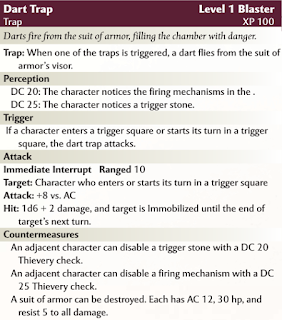Simon has got a really interesting thing going on his blog lately. In a series of posts he examines traps mechanically to gain a better understanding of how they might function exactly. For a while, I have thought that the best way to run traps is an organic and exploration based approach (If you happen to be at a loss as to how a trap might be run like this, I suggest reading the examples in Matt Finch's A Quick Primer for Old School Gaming).
Having myself only started role playing games as late as during 4E D&D, this approach was kind of an eye opener to me. I learned that traps should look like this.
Aside from encouraging the players to just press their "skill buttons" instead of making decisions, these traps (and this one in particular, since it is included in the 4E DMG) teaches new DMs by example that they should prepare all the characters' options and make them part of the trap. The DM should consider the chance of spotting it, the chance of disabling it and all the different actions that possibly can be taken including this trap.
The big problem occurs when a player tries to do something that is not covered in the stat block. Now the DM fumbles around looking for any information that might be used and probably ends up just assigning some arbitrary DC and making the player roll some dice, because the DM only knows that when a character steps in the designated square, an attack will be made with the character as a target. The DM does not know how the trap functions.
If the DM instead had a picture in his or her head of the mechanisms of this trap and how they interact, they would know the answer to every question and every action on the player's side intuitively. To be able to run traps organically and even without any dice rolls. I think the first step is to know the trap inside and out. Whatever the player tries to do, the DM should know how it logically should affect the trap.
I encourage you to follow along with the posts on traps on Simons blog. I might also write up some of my own examinations of traps for my own game here, as I certainly won't be using a trap without knowing exactly how it functions from this time forward.


No comments:
Post a Comment